What's New
Displaying results 4741 - 4750 of 4899
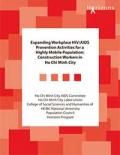
Resource | Publications,
The HIV epidemic in Vietnam is growing, and promotion of prevention behavior among vulnerable populations, such as migrant workers, is becoming increasingly critical. In Ho Chi Minh City (HCMC), the locus of the epidemic in Vietnam, efforts have been under way for several years to implement prevention efforts for migrant worker populations.
Led by the HCMC AIDS Committee and HCMC Labor Union, the main activity has utilized volunteer health communicators (HC) to visit workplaces and conduct HIV education activities. However, these efforts have reached only a relatively small number of the intended audience, and the impact of the current program is unclear. Local authorities want to scale up their efforts but require information on the most effective and least costly activities, as well as their potential for scale up.
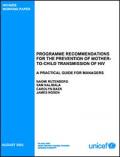
Resource | Guidelines,
This guide provides specific information for improving and scaling-up prevention of mother-to-child transmission of HIV (PMTCT) programs, based on what program managers and evaluators identify as successful strategies. The guide is intended for use by national-level PMTCT teams for starting or scaling up PMTCT programs. With appropriate adaptation, national officials can disseminate the guide to district level authorities, site managers, and health workers.
The recommendations in this guide draw on this body of knowledge, including primarily from an IATT-commissioned evaluation of the eleven pilot projects, carried out by the Population Council between March and December 2002 in close consultation with UNICEF and other Inter-Agency Task Team (IATT) members. Sources include progress reports from the country pilots, interviews, rapid assessments in Rwanda and Zambia and discussions at a collaborative analysis meeting held in December 2002.
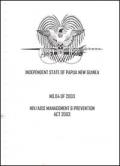
Resource | Laws and Policies,
Being an Act to give effect to the Basic Rights acknowledged in Preamble to the Constitution, in particular the rights and freedoms of -
(a) life, liberty, security of the person and protection of the law; and
(b) freedom of inhuman treatment; and...
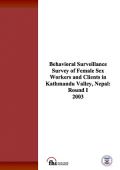
Resource | Publications,
This study was conducted among street and establishment-based female sex workers (FSWs) and their clients in Kathmandu. This is the first round of the Behavioral Surveillance Survey conducted among the two groups: FSWs and their clients in the Kathmandu Valley. The survey was carried out during the months of July and August 2001 to measure risk behaviors which are associated with the risk of HIV infection, such as condom use, sexual behaviors, knowledge of HIV/AIDS, reported cases of STI and their treatment behaviors, exposure to HIV/AIDS messages, and drug habits.
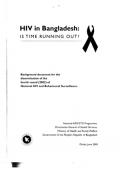
Resource | Publications,
For many years Bangladesh has been able to escape the HIV/AIDS epidemic that is affecting countries all around us. Now the results of the fourth round of national surveillance indicate that the country has no reason to be complacent. In the central part of the country, there is an upsurge of HIV infection among injection drug users. Fortunately, the virus has remained at low prevalence among the other vulnerable groups under surveillance.
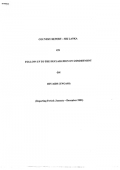
Resource | Publications,
The first case of HIV/AIDS in a Sri Lankan was reported in 1987 and the first indigenous transmission of HIV was reported in 1989. The National Working Group on HIV Estimates convened by the National STD/AIDS Control Programme (NSACP) estimates the current burden of decease as between 4700 (low) to 7200 (high).
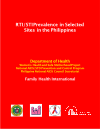
Resource | Publications,
This study aimed to estimate the magnitude of the STI problem in the general population and to provide data to improve RTI/STI case management guidelines.
The study revealed that STI prevalence, particularly genital ulcer disease, remains low in the general population in the Philippines. However, young people have relatively high prevalence of genital chlamydial infection. The study also demonstrated moderately high prevalence of established risk behaviors such as men having unprotected commercial sex encounters. There is a need to provide new approaches and strengthen current STI interventions to sustain the low STI rates and lower chlamydial infections. The foregoing findings revealed that majority of the STI cases are asymptomatic. Since current laboratory tests are expensive and simple and cheap laboratory tests are still unavailable, there is a need to develop a strategy to reach and treat asymptomatic STI cases.
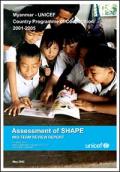
Resource | Publications,
School-Based Healthy Living and HIV/AIDS Prevention Education (SHAPE) was initiated jointly by the Ministry of Education of the Government of Myanmar and UNICEF in 1997. SHAPE is a life skills project with a emphasis on prevention of HIV/AIDS and its related problems of STI and drug abuse.
SHAPE implementation began in 30 townships during the 1998/99 school year and was expanded to 30 more townships in the two years that followed. Now SHAPE is being implemented in 104 townships. This assessment focused only upon the initial townships where results would be more apparent.
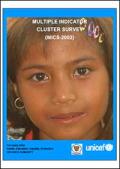
Resource | Publications,
UNICEF developed the Multiple Indicator Cluster Survey (MICS) to monitor goals established at the World Summit for Children (WSC) held in New York in 1990. But it is also consistent with many monitoring needs of the Millennium Development Goals (MDG), as well as those of the more recent World Fit for Children (WFFC) that many countries are now using for human development planning into the 21st Century. MICS was created especially to meet the needs of developing countries lacking reliable routine sources of statistics and/or experience in carrying out reliable household surveys to measure performance relative to the WSC and, now, the Millennium Development and WFFC Goals.
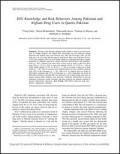
Resource | Publications,
Situated on the Pakistan-Afghan border, Quetta is home to growing numbers of Afghan refugees. We studied HIV knowledge and risk behaviors among Pakistani and Afghani drug users between July 2001 and November 2001. Of 959 drug users, all were male and the majority used heroin. Most were Pakistani (84.8%), 14.9% were Afghani, and 0.3% were Iranian. Relative to Pakistani drug users, a higher proportion of Afghanis reported no formal education, homelessness, and unemployment (p < .001).
Afghanis were more likely to have used an opiate as their first illicit drug (16% vs. 7%, p < .001), to have ever injected (18.8% vs. 12.3%, p = .04), to report needle sharing (72.2% vs. 48.2%, p = .08), or to report a drug user in their family (p = .08). None of sexually active Afghanis had ever used a condom compared with 5.0% of the Pakistanis (p = .01). Only 4.3% of Afghans had ever heard of HIV/AIDS compared with 18.3% of Pakistanis (p < .001). Extremely low levels of HIV/AIDS awareness and high HIV risk behaviors were evident among drug users in Quetta, among whom Afghanis were especially vulnerable. Interventions to prevent transition to injection, needle exchange, and drug treatment are urgently required to prevent blood-borne infections.





